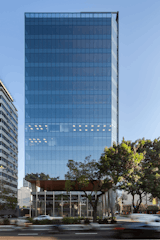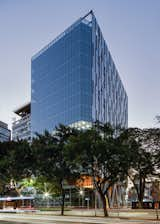Details
Credits
From Königsberger Vannucchi Arquitetos
Rebouças Avenue, in the western of São Paulo, is undergoing significant transformations. As a key link between two of the city’s economic hubs – Paulista and Faria Lima avenues – Rebouças has been experiencing a shift that plays a critical role in the city’s dynamics. It is part of one of the Urban Transformation Axes defined by the Master Plan, which aims to integrate employment, housing, and leisure in areas well-served by metro stations and bus corridors.
It was in this context that Königsberger Vannucchi designed the architecture of HY Pinheiros, a mixed-use project born from the partnership between Hire Capital and construction firm Porto Ferraz. The building’s primary use is triple-A corporate offices with LEED Gold certification, occupying a 2,155-square-meter plot at the corner of Rebouças Avenue and Teçaindá Street. The project’s solution was based on two main requirements: (1) creating large, column-free floor plates to optimize space usage, and (2) fully explore the views overlooking the Jardins neighborhood.
The first requirement led to the technical solution of aligning the five elevators and placing columns only on the perimeter of the tower, resulting in open floor areas with spans of 27,85 meters by 25 meters, which allows flexible layouts for each floor.
The second requirement was addressed by elevating the first office floor to what would conventionally be the fourth level, above the treetops and rooftops along Rebouças. This created a quadruple-height ground floor, which was designed to promote public permeability facing the avenue and accommodate complementary functions for HY Pinheiros on the opposite side.
“This elevation solved the incorporation of a retail space on the ground floor, forming the active façade of the development. The commercial area was designed as a glass box, entirely independent of the building’s structure, enhancing the perception of a wide, open span,” says Alexandre Daud, Associate Director at Königsberger Vannucchi. “The store’s structure is set back from the first office slab and the columns along Teçaindá Streets”, he adds.
These ground-level columns were key in structurally enabling the large central span and spacious floor plates. Their development was the result of extensive research, information exchanges, and even a mockup test on-site. In the end, their design not only resolved structural challenges but also created a striking visual element in the cityscape.
The corporate lobby extends towards Teçaindá Street, highlighting the building’s main entrance. Between the lobby, retail space, and Rua Teçaindá, there is a covered, open public area that naturally extends the sidewalk, serving as a pathway for those moving between Rebouças and the metro station on Pinheiros Street.
Another design feature that emphasizes the semi-public nature of the ground floor is the continuation of the ceiling from the store into the lobby, creating a seamless connection that appears to originate above the elevator doors. There is a continuity between the architecture and interior design, both developed by Königsberger Vannucchi.
Urban kindnesses: a new boost to the city’s dynamism
HY Pinheiros is characterized by its balance between meeting private demands and offering quality public space. In a corridor lacking in gathering places, the inviting ground floor attracts even those who don’t work in the building, turning the avenue itself into a destination and generating activity on the sidewalks.
The building is located just one block from a metro station in an area equipped with bike lanes and well-served by bus lines, reducing the need for cars. To further encourage the use of non-polluting transportation, the design includes a bike storage area with showers on the ground floor.
In addition to covered walkways, there will also be a publicly accessible garden during business hours.
LEED certification: solutions to mitigate environmental impacts
Technical specifications were made with the goal of meeting LEED certification standards. For instance, the lighting design specified efficient fixtures and bulbs to reduce energy consumption.
All specified glass materials were studied to achieve a sufficient level of heat reduction, promoting energy savings in air conditioning use without sacrificing natural light.
The air conditioning system includes air filtration, and users also have the option of natural ventilation in the office spaces. Additionally, the underground levels feature a gas exhaust system. The rooftop is partially occupied by a green roof, and the building has a rainwater harvesting system and stormwater retention tank, reducing potable water consumption and reliance on public drainage systems during heavy rains.



